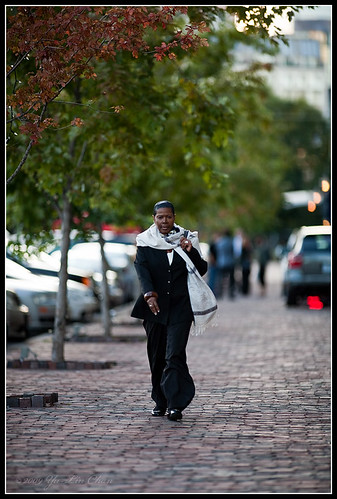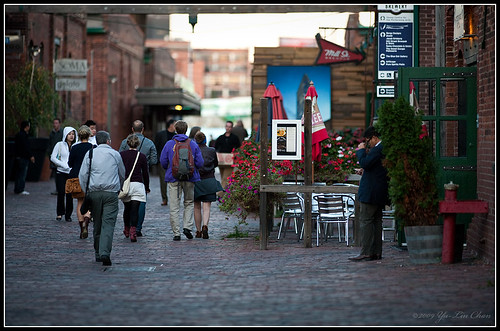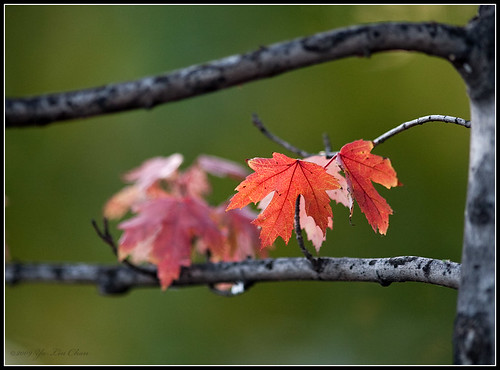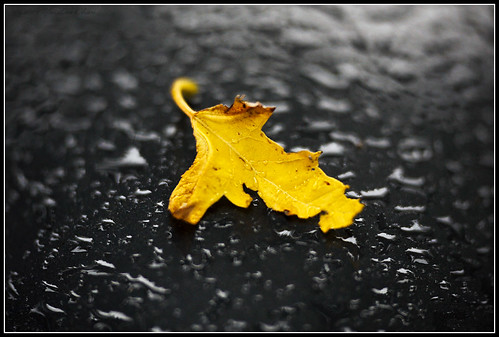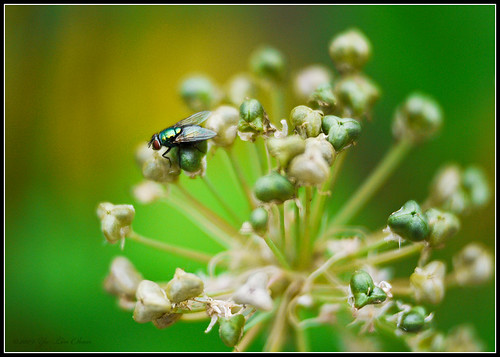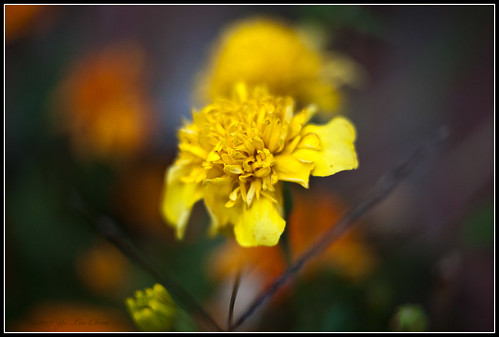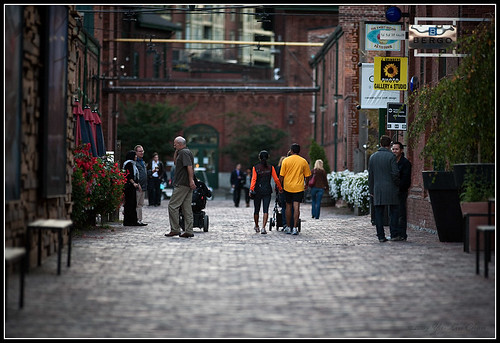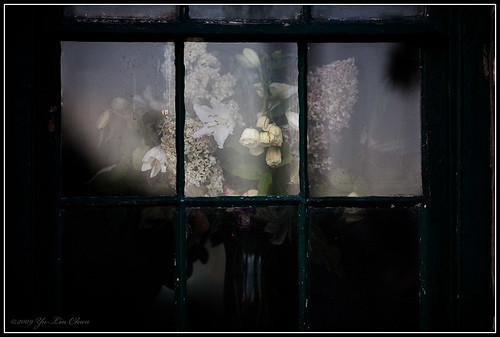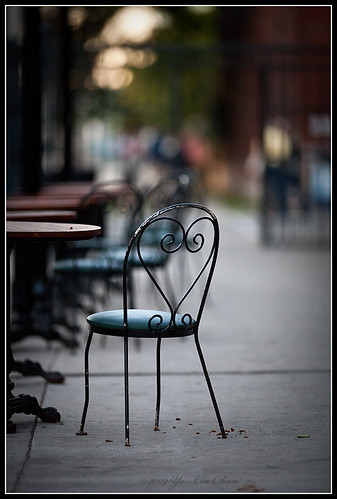C-Mount (C stands for Cine) lenses, once exclusively used with 16mm movie cameras, TV cameras, and sometimes triocular microscopes, has found a home with a growing number of micro 4/3 digital camera users. With a very short flange focal distance, c-mount lenses were not usable on anything else other than 16mm and TV cameras. The introduction of Micro-4/3 mount has changed that.
 Panasonic G1 with Kern-Paillard Switar 25mm f1.4. Larger Picture.
Panasonic G1 with Kern-Paillard Switar 25mm f1.4. Larger Picture.Like the c-mount, Micr0-4/3 mount also has a short flange focal distance of approximately 20mm. In theory, this is still longer than c-mount and therefore c-mount lenses should not be able to focus to infinity. But, due to the mirror-less design of the Micro-4/3 camera, a Micro-4/3 adapter for c-mount lenses can extend and allow c-mount lenses to mount closer to the sensor, allowing them to focus to infinity. Of course, there are limitations. Larger c-mount lenses usually can not mount close enough to the sensor, and those will not focus to infinity.
 C-Mount Adapter for Micro-4/3 with a 25mm lens mounted. Larger Picture.C-Mount Lenses -- Pros
C-Mount Adapter for Micro-4/3 with a 25mm lens mounted. Larger Picture.C-Mount Lenses -- Pros
Small Size -- Most C-Mount lenses are small, compared to 35mm lens equivalent. A 25mm lens can be 2x to 4x smaller than a 35mm lens with same maximum aperture, due to smaller image circle of the c-mount.
 Size Comparision -- From left to right: Canon EF 35mm f1.4, Angenieux 75mm f2.5, Kern-Pillard Switar 25mm f1.4. Larger Picture.Very Fast Maximum Aperture
Size Comparision -- From left to right: Canon EF 35mm f1.4, Angenieux 75mm f2.5, Kern-Pillard Switar 25mm f1.4. Larger Picture.Very Fast Maximum Aperture -- With few exceptions, most c-mount lenses have very large maximum apertures. For example, you can often find 25mm c-mount lenses with f0.95 maximum aperture. Even 50mm f0.95 is not uncommon in c-mount.
 Example of a very fast 25mm lens -- JML 25mm f0.95 TV Lens. Larger Picture. More Samples here.Well made
Example of a very fast 25mm lens -- JML 25mm f0.95 TV Lens. Larger Picture. More Samples here.Well made -- All the c-mount lenses that I have seen are made of metal and glass. I haven't gotten one that has any plastics. OK, so I am old and I am partial to stuff that's made of metal, and in real practical terms, there's probably not a bit of different whether a lens is made of plastic or metal. But, these lenses are all well made.
Imaging characteristics -- Many of the c-mount lenses have unique imaging characteristics, especially the bokeh. Some lenses, such as the Dallmeyer 1 inch f1.5, and Ross 25mm f1.9, have swirling out of focus backgrounds. Often, wider angle c-mount lenses from 25mm down, do not have very good corner performance, because they were designed for a much smaller image circle of the 16mm film. To me at least, I use these lenses especially for this kind of characteristics. Longer lenses from 40mm or longer, have much better corner sharpness.
 Distinctive Image Characteristics -- Dallmeyer 1 inch f1.5. Larger Picture. More Samples here.C-Mount Lenses -- ConsSevere Vignetting with wide angle lenses
Distinctive Image Characteristics -- Dallmeyer 1 inch f1.5. Larger Picture. More Samples here.C-Mount Lenses -- ConsSevere Vignetting with wide angle lenses -- Most lenses 25mm or wider exhibit vignetting when mounted on Micro-4/3 cameras.
 Vignetting when stopped down -- SOM Berthiot Lytar 25mm f1.9 @ f16. Larger Picture. More samples of this lens here.Ultra Wide Angles Not Usable
Vignetting when stopped down -- SOM Berthiot Lytar 25mm f1.9 @ f16. Larger Picture. More samples of this lens here.Ultra Wide Angles Not Usable -- Most C-mount lenses made for 16mm movie cameras from 16mm or wider have an even smaller imaging circle and what you will see on your camera is an image with black surroundings, sort of like a circular fish eye lens effect.
Haze, Dust, Focusing Issues -- After many decades, many of these c-mount lenses have accumulated a fine layer of dust inside the lens, giving them a soft focus effect when used near maximum apertures. Also, due to grease dried up in the focusing ring, many of these lenses are difficult to focus, or feels choppy when focusing. Finding a shop that can clean and lube these lenses have becoming more and more difficult.
Image Circle
Since 16mm film is smaller than the Micro-4/3 sensor, most c-mount lenses with a focal length of 25mm or wider will vignette, sometimes very severely. There are exceptions, of course, but finding out which one will, or will not is difficult until you have tried it. In my experience, most 25mm lenses will barely cover the Micro-4/3 sensor wide open. As you stop down the lens, you will see more vignetting. Any lens from 16mm down, you will most likely see the image in a dark circle, because the image circle is reduced as the lens gets wider (but still usable on 16mm movie cameras.)
C-Mount lenses above 25mm seems to cover the Micro-4/3 sensor without problem.
Lens ChoicesBeing a universal mount like the M42 lenses, c-mount lenses also have many choices in focal length from different manufacturers.
Focal Lengths -- For 16mm movie cameras, you can find lenses as wide as 10mm, or even wider. Often, very wide angle lenses do not have focusing rings. They simply do not require focusing from about a meter to infinity. Most popular and usable focal range used on Micro-4/3 cameras is from 25mm to 75mm. The longest lens I have come across is a Kodak Cine Ektar 152mm f4. I am sure there are longers ones.
Manufacturers -- There are many c-mount lens manufacturers. Most popular and famous ones are made by Kern-Paillard for its Bolex movie cameras. Angenieux also made some fantastic optics for C-Mount. The British made some exotic and sought after c-mount lenses. They include Dallmeyer, Ross, Cook/Taylor & Hobson, just to name a few. The Japanese also made C-Mount lenses. They include Kinotel, Pentax (Cosmicar), Canon, Sony, and others.
 A selection of c-mount primes from 25mm to 154mm. Larger Picture.
A selection of c-mount primes from 25mm to 154mm. Larger Picture.One thing you need to keep in mind is that most c-mount lenses are used and very old, with the exception of Closed-Circuit TV c-mount lenses, because I don't believe they still make new c-mount 16mm movie lenses any more.
I have many more sample pictures from various c-mount lenses. You can brows them
here.
